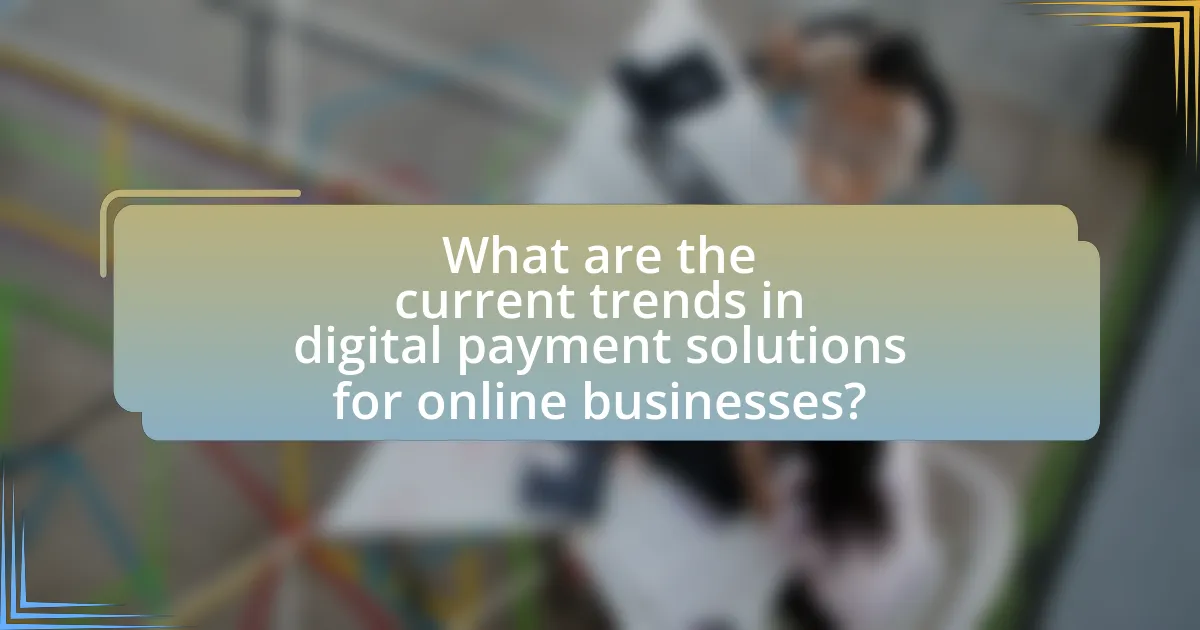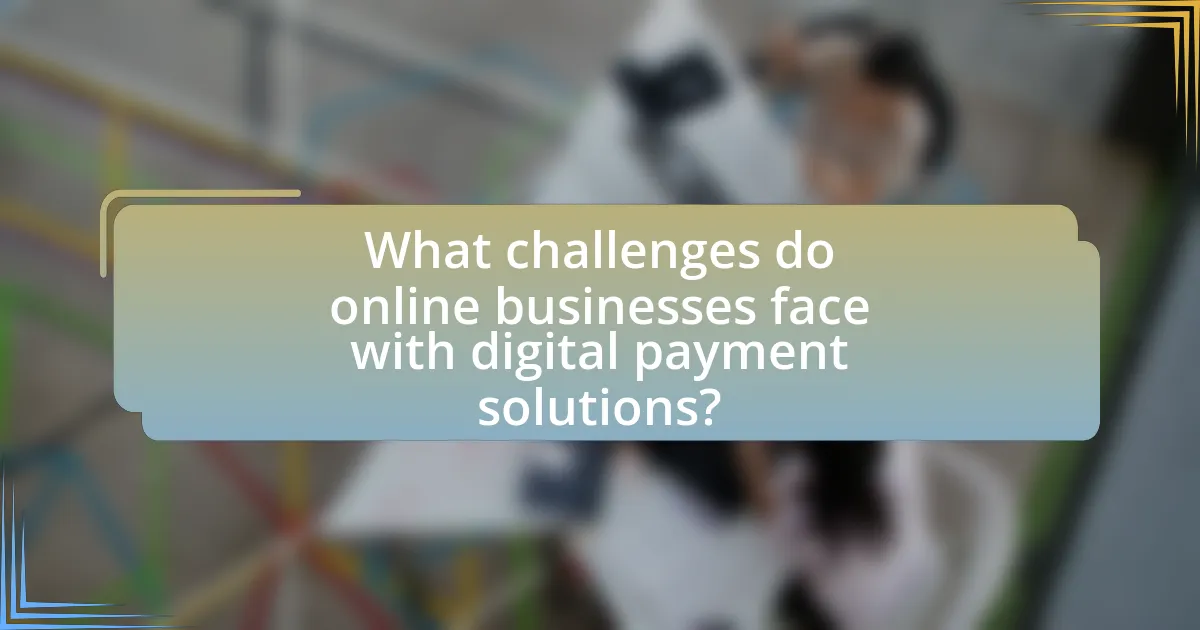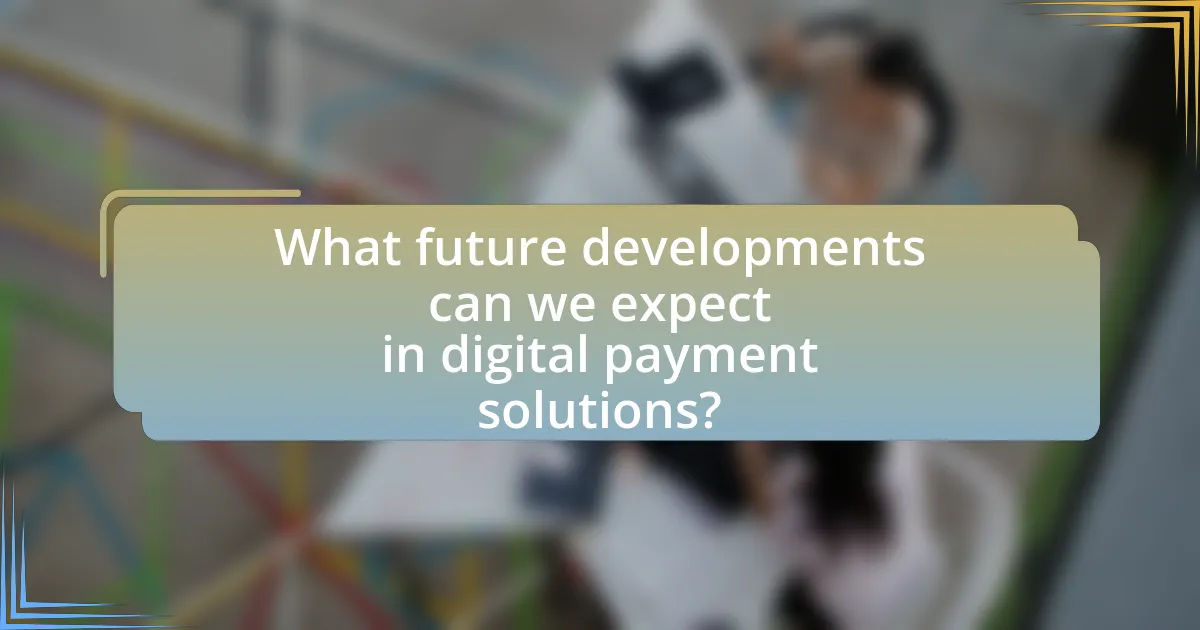The article focuses on the current trends in digital payment solutions for online businesses, highlighting the rise of contactless payments, the integration of cryptocurrencies, and the use of artificial intelligence for fraud detection. It examines how consumer preferences are shaping these trends, with an emphasis on convenience, security, and flexibility in payment methods. Additionally, the article discusses the impact of technological advancements, regulatory changes, and data privacy laws on payment solutions, as well as the challenges businesses face, such as security concerns and transaction fees. Finally, it explores future developments in digital payments, including the potential of biometric authentication and the influence of subscription models on payment systems.

What are the current trends in digital payment solutions for online businesses?
Current trends in digital payment solutions for online businesses include the rise of contactless payments, the integration of cryptocurrencies, and the increasing use of artificial intelligence for fraud detection. Contactless payments have surged, with a report from Statista indicating that the global contactless payment market is expected to reach $6 trillion by 2024. The adoption of cryptocurrencies is also gaining traction, as businesses like Tesla and Overstock accept Bitcoin, reflecting a shift towards decentralized finance. Additionally, AI technologies are being implemented to enhance security measures, with a study by Juniper Research predicting that AI in payment fraud detection will save businesses $27 billion by 2024. These trends highlight the evolving landscape of digital payments, driven by consumer demand for convenience and security.
How are consumer preferences shaping these trends?
Consumer preferences are significantly shaping trends in digital payment solutions for online businesses by driving demand for convenience, security, and flexibility. As consumers increasingly favor seamless transactions, businesses are adopting payment methods that streamline the checkout process, such as one-click payments and mobile wallets. According to a 2022 survey by Statista, 60% of online shoppers prioritize fast and easy payment options, which has led to the rise of digital wallets like PayPal and Apple Pay. Additionally, heightened concerns about data security have prompted businesses to implement advanced encryption and fraud detection technologies, aligning with consumer expectations for safe transactions. This shift towards consumer-centric payment solutions illustrates how preferences directly influence the evolution of digital payment trends.
What payment methods are gaining popularity among consumers?
Digital wallets and contactless payments are gaining popularity among consumers. According to a report by Statista, the number of digital wallet users worldwide is expected to reach 4.4 billion by 2025, driven by convenience and security. Additionally, contactless payment transactions have surged, with a 150% increase reported in 2020 alone, as consumers prefer quick and hygienic payment options. These trends indicate a significant shift towards digital and contactless payment methods in the consumer landscape.
How does user experience influence payment solution choices?
User experience significantly influences payment solution choices by determining customer satisfaction and retention. A seamless, intuitive payment process enhances user confidence and encourages repeat transactions, as evidenced by a study from the Baymard Institute, which found that 18% of users abandon their carts due to a complicated checkout process. Additionally, positive user experiences with payment solutions, such as fast processing times and multiple payment options, lead to higher conversion rates, as reported by Statista, which indicates that 70% of consumers prefer payment methods that are easy to use. Therefore, businesses that prioritize user experience in their payment solutions are more likely to attract and retain customers.
What technological advancements are driving these trends?
Technological advancements driving trends in digital payment solutions for online businesses include the rise of blockchain technology, artificial intelligence, and mobile payment systems. Blockchain enhances security and transparency in transactions, reducing fraud and increasing trust among users. Artificial intelligence streamlines payment processing and fraud detection, enabling faster and more efficient transactions. Mobile payment systems, such as digital wallets and contactless payments, cater to consumer demand for convenience and speed, with a report from Statista indicating that mobile payment transaction value is expected to reach $12 trillion by 2025. These advancements collectively transform the landscape of online payments, making them more secure, efficient, and user-friendly.
How is artificial intelligence impacting digital payment solutions?
Artificial intelligence is significantly enhancing digital payment solutions by improving transaction security, streamlining processes, and personalizing user experiences. AI algorithms analyze transaction data in real-time to detect fraudulent activities, reducing the risk of financial loss; for instance, according to a report by Juniper Research, AI-driven fraud detection can decrease false positives by up to 80%. Additionally, AI automates payment processing, enabling faster transactions and reducing operational costs for businesses. Furthermore, AI technologies facilitate personalized recommendations and targeted marketing, which can increase customer engagement and satisfaction in digital payment platforms.
What role does blockchain technology play in modern payment systems?
Blockchain technology serves as a foundational element in modern payment systems by enabling secure, transparent, and efficient transactions. It facilitates peer-to-peer payments without the need for intermediaries, reducing transaction costs and processing times. For instance, blockchain’s decentralized ledger technology ensures that all transactions are recorded in a tamper-proof manner, enhancing security and trust among users. According to a report by the World Economic Forum, blockchain could account for 10% of global GDP by 2027, highlighting its significant impact on financial systems. Additionally, cryptocurrencies, which operate on blockchain technology, allow for cross-border transactions that are faster and less expensive compared to traditional banking methods.
What regulatory changes are affecting digital payment solutions?
Regulatory changes affecting digital payment solutions include the implementation of the European Union’s Revised Payment Services Directive (PSD2), which mandates strong customer authentication and enhances consumer protection. This directive, effective since January 2018, aims to increase competition and innovation in the payment services market while ensuring secure transactions. Additionally, the Financial Action Task Force (FATF) has introduced guidelines requiring cryptocurrency exchanges to comply with anti-money laundering (AML) regulations, impacting how digital payment solutions handle cryptocurrencies. These changes reflect a global trend towards stricter oversight and security in digital financial transactions.
How do compliance requirements vary across different regions?
Compliance requirements vary significantly across different regions due to varying legal frameworks, cultural norms, and regulatory bodies. For instance, the European Union enforces the General Data Protection Regulation (GDPR), which mandates strict data protection and privacy standards, while the United States has a more fragmented approach with regulations like the California Consumer Privacy Act (CCPA) and sector-specific laws. Additionally, Asia-Pacific regions may have their own unique compliance standards, such as the Personal Data Protection Act (PDPA) in Singapore, which emphasizes consent and data protection. These differences necessitate that businesses adapt their compliance strategies to align with local laws, ensuring they meet the specific requirements of each region they operate in.
What are the implications of data privacy laws on payment solutions?
Data privacy laws significantly impact payment solutions by imposing strict regulations on how personal and financial data is collected, stored, and processed. These laws, such as the General Data Protection Regulation (GDPR) in Europe and the California Consumer Privacy Act (CCPA) in the United States, require payment solution providers to implement robust data protection measures, including obtaining explicit consent from users before processing their data. Compliance with these regulations often necessitates increased transparency in data handling practices, which can lead to enhanced consumer trust but may also increase operational costs for businesses. Furthermore, non-compliance can result in substantial fines; for instance, GDPR violations can incur penalties of up to 4% of a company’s global annual revenue. Thus, data privacy laws shape the operational landscape of payment solutions, driving innovation in secure payment technologies while ensuring consumer rights are protected.

What challenges do online businesses face with digital payment solutions?
Online businesses face several challenges with digital payment solutions, including security concerns, transaction fees, and integration issues. Security is a major challenge, as online businesses must protect sensitive customer data from breaches; in 2021, 85% of organizations experienced a phishing attack, highlighting the risks involved. Transaction fees can significantly impact profit margins, with some payment processors charging up to 3% per transaction, which can accumulate for high-volume sellers. Additionally, integration of payment solutions with existing systems can be complex and time-consuming, often requiring technical expertise that many small businesses may lack. These challenges can hinder the efficiency and growth of online businesses in a competitive digital marketplace.
How do security concerns affect the adoption of digital payment methods?
Security concerns significantly hinder the adoption of digital payment methods by creating distrust among consumers and businesses. When individuals perceive a high risk of fraud, data breaches, or identity theft associated with digital transactions, they are less likely to engage in using these payment solutions. For instance, a 2021 survey by the Federal Reserve indicated that 40% of consumers cited security as a primary reason for hesitance in adopting digital payment methods. This apprehension leads to lower transaction volumes and can stifle innovation in digital payment technologies, as companies may be reluctant to invest in solutions that consumers do not trust.
What are the most common security threats to digital payment systems?
The most common security threats to digital payment systems include phishing attacks, data breaches, malware, and account takeover. Phishing attacks involve fraudulent communications that trick users into revealing sensitive information, while data breaches occur when unauthorized individuals access confidential payment data, often leading to financial loss. Malware can infect devices to capture payment information, and account takeover happens when attackers gain control of user accounts, allowing them to make unauthorized transactions. According to a report by the Cybersecurity and Infrastructure Security Agency, these threats have increased significantly, with phishing attacks rising by 400% in recent years, highlighting the urgent need for robust security measures in digital payment systems.
How can businesses mitigate these security risks?
Businesses can mitigate security risks by implementing robust cybersecurity measures, including encryption, multi-factor authentication, and regular security audits. These strategies protect sensitive data during transactions and ensure that only authorized users can access systems. For instance, according to a report by Cybersecurity Ventures, global spending on cybersecurity is expected to exceed $1 trillion from 2017 to 2021, highlighting the importance of investing in security to prevent breaches. Additionally, training employees on security best practices can reduce human error, which is a significant factor in security incidents.
What are the costs associated with implementing digital payment solutions?
The costs associated with implementing digital payment solutions include transaction fees, setup costs, maintenance expenses, and compliance costs. Transaction fees typically range from 1.5% to 3% per transaction, depending on the payment processor. Setup costs can vary widely, often between $0 to several thousand dollars, depending on the complexity of the system and the provider chosen. Maintenance expenses may include monthly service fees, which can range from $10 to $100, and costs for software updates or technical support. Compliance costs arise from adhering to regulations such as PCI DSS, which can involve additional expenses for security measures and audits. These costs collectively impact the overall budget for businesses adopting digital payment solutions.
How do transaction fees impact online business profitability?
Transaction fees significantly reduce online business profitability by directly impacting the net revenue from sales. When a business processes payments, it incurs fees from payment processors, which can range from 1% to 3% of the transaction amount, depending on the provider and payment method. For instance, if an online retailer sells a product for $100 and incurs a 2.5% transaction fee, the cost of the fee would be $2.50, reducing the effective revenue to $97.50. This reduction in revenue can accumulate, especially for businesses with high sales volumes, leading to decreased profit margins. Furthermore, businesses may need to adjust their pricing strategies to accommodate these fees, which can affect competitiveness in the market.
What hidden costs should businesses be aware of when choosing payment solutions?
Businesses should be aware of several hidden costs when choosing payment solutions, including transaction fees, chargeback fees, and currency conversion fees. Transaction fees can vary significantly between providers and may include a percentage of each sale as well as flat fees per transaction. Chargeback fees arise when customers dispute a transaction, leading to additional costs for the business, often exceeding the original transaction amount. Currency conversion fees apply when transactions involve different currencies, which can add unexpected costs to international sales. According to a study by the Federal Reserve, these fees can accumulate and impact overall profitability, making it crucial for businesses to thoroughly evaluate all potential costs associated with payment solutions before making a decision.
How do businesses ensure a seamless payment experience for customers?
Businesses ensure a seamless payment experience for customers by integrating multiple payment options, optimizing the checkout process, and utilizing secure payment gateways. By offering various payment methods such as credit cards, digital wallets, and bank transfers, businesses cater to diverse customer preferences, which enhances convenience. Streamlining the checkout process minimizes the number of steps required to complete a transaction, reducing cart abandonment rates; for instance, a study by Baymard Institute found that 69.57% of online shoppers abandon their carts due to complicated checkout processes. Additionally, employing secure payment gateways protects customer data, fostering trust and encouraging repeat purchases. According to a report by Statista, 17% of consumers abandon purchases due to security concerns, highlighting the importance of security in ensuring a smooth payment experience.
What best practices can enhance the checkout process?
To enhance the checkout process, businesses should implement a streamlined user interface, offer multiple payment options, and ensure mobile optimization. A streamlined user interface reduces friction, leading to higher conversion rates; studies show that 70% of users abandon their carts due to complicated checkout processes. Offering multiple payment options, including digital wallets and buy-now-pay-later services, caters to diverse customer preferences, which can increase sales by up to 30%. Additionally, optimizing the checkout for mobile devices is crucial, as mobile commerce accounted for 54% of total e-commerce sales in 2021, highlighting the need for a seamless mobile experience.
How can businesses optimize payment solutions for mobile users?
Businesses can optimize payment solutions for mobile users by implementing mobile-friendly payment gateways that support various payment methods, including digital wallets and contactless payments. This approach enhances user experience by providing quick and secure transactions, which is crucial as mobile commerce continues to grow; for instance, Statista reported that mobile payments are expected to reach $12 trillion by 2025. Additionally, ensuring that the payment process is streamlined and requires minimal steps can reduce cart abandonment rates, which, according to Baymard Institute, can be as high as 69.57% for mobile users. By focusing on these strategies, businesses can effectively cater to the increasing demand for efficient mobile payment solutions.

What future developments can we expect in digital payment solutions?
Future developments in digital payment solutions will likely include increased adoption of blockchain technology, enhanced security measures through biometric authentication, and the integration of artificial intelligence for fraud detection. Blockchain technology is expected to streamline transactions and reduce costs, as evidenced by the growing number of businesses implementing cryptocurrencies for payments. Enhanced security measures, such as biometric authentication, are being adopted to combat rising cyber threats; a report from Juniper Research indicates that biometric payment authentication will reach $2.5 trillion by 2024. Additionally, artificial intelligence is being utilized to analyze transaction patterns and detect anomalies, with a projected market growth for AI in payment processing expected to exceed $10 billion by 2026. These advancements will collectively improve efficiency, security, and user experience in digital payment solutions.
How will emerging technologies influence the future of digital payments?
Emerging technologies will significantly enhance the future of digital payments by increasing transaction speed, security, and user convenience. Technologies such as blockchain, artificial intelligence, and biometric authentication are transforming payment processes. For instance, blockchain enables faster cross-border transactions with lower fees, while AI enhances fraud detection and personalized payment experiences. According to a report by McKinsey & Company, the adoption of digital payment solutions is expected to grow by 20% annually, driven by these technological advancements. Additionally, biometric authentication, such as fingerprint and facial recognition, is projected to reduce fraud rates by up to 50%, making transactions safer for consumers.
What potential does biometric authentication hold for payment security?
Biometric authentication has significant potential for enhancing payment security by providing a unique and difficult-to-replicate method of verifying user identity. This technology leverages physical characteristics such as fingerprints, facial recognition, or iris scans, which are inherently tied to the individual, making unauthorized access considerably more challenging. According to a report by the International Journal of Information Management, biometric systems can reduce fraud rates by up to 90% compared to traditional password-based systems. This dramatic decrease in fraud is attributed to the difficulty of replicating biometric traits, thus increasing consumer trust and adoption of digital payment solutions.
How might cryptocurrencies change the landscape of online payments?
Cryptocurrencies may significantly alter the landscape of online payments by providing faster, cheaper, and more secure transaction methods. Traditional payment systems often involve intermediaries, leading to delays and higher fees; cryptocurrencies enable peer-to-peer transactions that can be processed almost instantly and with minimal costs. For instance, Bitcoin transactions can be completed in approximately 10 minutes, while international wire transfers can take several days and incur fees ranging from $20 to $50. Additionally, the decentralized nature of cryptocurrencies reduces the risk of fraud and chargebacks, enhancing security for both consumers and merchants. According to a report by the Cambridge Centre for Alternative Finance, the number of cryptocurrency users reached over 300 million in 2021, indicating a growing acceptance and potential for mainstream adoption in online payments.
What trends should online businesses watch for in the coming years?
Online businesses should watch for the increasing adoption of digital wallets and contactless payments in the coming years. As consumer preferences shift towards convenience and speed, digital wallets like Apple Pay and Google Pay are projected to grow significantly, with a forecasted increase in usage by over 30% by 2025 according to Statista. Additionally, the rise of cryptocurrencies as a payment option is gaining traction, with a report from Deloitte indicating that 75% of consumers are interested in using digital currencies for transactions. These trends highlight the need for online businesses to adapt their payment solutions to meet evolving consumer demands and enhance transaction security.
How will the integration of social media and payments evolve?
The integration of social media and payments will evolve towards seamless, in-app purchasing experiences that enhance user engagement and streamline transactions. As platforms like Instagram and Facebook continue to develop features such as shoppable posts and integrated payment systems, users will increasingly make purchases without leaving the app. According to a report by eMarketer, social commerce sales in the U.S. are projected to reach $36.09 billion by 2021, highlighting the growing trend of consumers shopping directly through social media. This evolution will be driven by advancements in technology, user preferences for convenience, and the need for businesses to adapt to changing consumer behaviors.
What impact will the rise of subscription models have on payment solutions?
The rise of subscription models will significantly influence payment solutions by increasing the demand for automated, recurring billing systems. As businesses adopt subscription-based revenue streams, they require payment solutions that can handle regular transactions seamlessly, ensuring customer retention and cash flow stability. According to a report by McKinsey, subscription services have grown by more than 350% in recent years, highlighting the need for payment processors to adapt to this trend. This shift necessitates enhanced security measures, flexible payment options, and integration capabilities with various platforms to accommodate diverse customer preferences and reduce churn rates.
What practical steps can online businesses take to stay ahead in digital payments?
Online businesses can stay ahead in digital payments by adopting advanced payment technologies, enhancing security measures, and offering diverse payment options. Implementing technologies such as mobile wallets and contactless payments can streamline transactions, as evidenced by a 2021 report from Statista indicating that mobile payment users are expected to reach 1.31 billion globally by 2023. Additionally, prioritizing security through measures like two-factor authentication and PCI compliance can build customer trust; a 2020 survey by PwC found that 61% of consumers are concerned about online payment security. Finally, providing multiple payment methods, including cryptocurrencies and buy-now-pay-later options, caters to varying customer preferences, as 45% of consumers prefer businesses that offer multiple payment options according to a 2022 study by PayPal.





